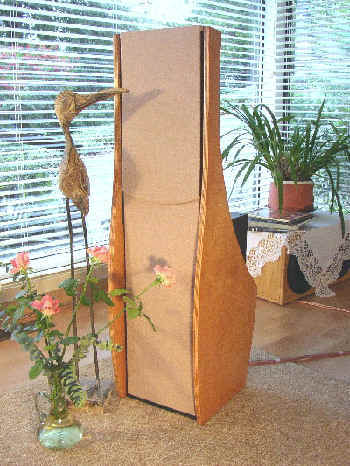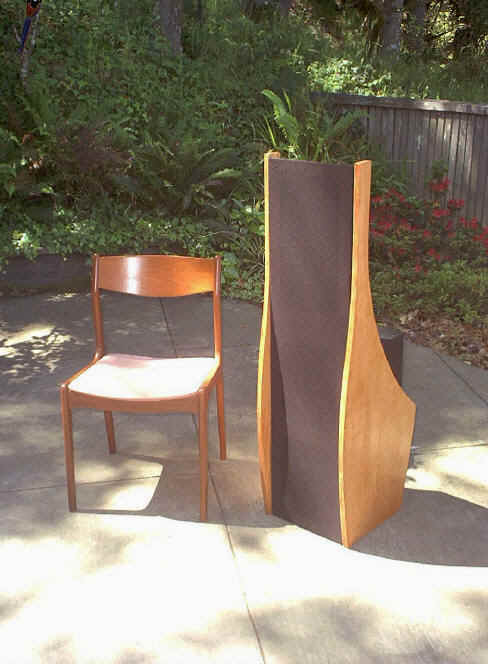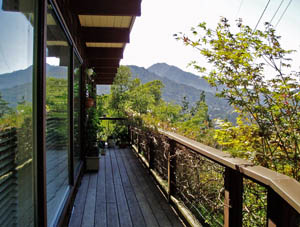| |

| Challenge | Requirements
| Supplies | Promotion | Subwoofer
| Photos | Reviews
| ASP | FAQ | Revision
0.1 | Revision 2 | ORION-3
|
ORION-4 |
ORION-5 |
The challenge
to
build a state-of-the-art loudspeaker yourself
+++ Build this unique loudspeaker yourself or
let us build it for you +++
My experience with the Beethoven series, the Vivaldi, and PHOENIX, has led to a new design,
which captures the essential sonic features of those speakers, except in a smaller package,
one that would be more acceptable in many domestic situations. I named the
loudspeaker


It should be understood that engineering is about trade-offs. In this case I have given up some
maximum volume capability below 40 Hz, that may be required for a few music
recordings when played at very high levels, while maintaining an extended frequency range
down to 20 Hz and gradual 2nd order roll-off below it. In return I have a speaker with
seamless integration over the whole frequency range, with impactfull dynamics, a
speaker that sets up a wide, tall and deep sound stage, yet with pin point
localization of instruments and voices, with speed and warmth. All this, of
course, only for well recorded material. The speakers disappear and what remains
is the panorama of sound and the experience of music. I
am very pleased with the accuracy and balance of sonic
attributes that this speaker achieves. Combined with its relatively small size
and its looks it represents to me an ultimate
speaker, one that I could live with for a long time, because it provides such a
satisfying musical illusion and experience.
The ORION design manifests to me what Saint-Exupéry mused about when he
described his airplane in "Night Flight" and wrote something like: "A
machine is not perfect when you cannot add anything more to it, but when you
cannot remove anything without destroying its function." Thus the
appearance of the ORION also exemplifies the Bauhaus motto: "Form follows
function".
I sell detailed construction plans, blank printed circuit
boards and a CD with test signals. You can also order the fully assembled and
tested electronics, a flatpack of precut wooden parts or partially assembled
cabinets and even wiring harnesses to hook up the drivers. This leaves to you the
the pieces that you feel comfortable with doing yourself. For extra money we can
deliver the complete ORION System to your doorstep, ready to play. It is up to
you how you want to take the ORION challenge. Either way can lead to the same
world-class speaker system.
ORION owners have access to helpful information and
updates. The design is stable and has proven itself over a number of years now,
but I still keep my eyes, ears and mind open for worthwhile
revisions.
These are the specifications:
- Open baffle cabinet
Outside dimensions: Height 46.25" - Width 13"
Depth 2" at top, 12" at base, 16" at 14" up
- Weight 60 lb (27 kg)
- 3-way active speaker system
- Crossovers at 120 Hz and 1440 Hz, both LR4 (24 dB/oct)
- Crossover/Equalizer
using two ORION ASP printed circuit boards
- Tweeter - Seas T25CF002 - No, not a ribbon -
42" up, no 2.8 kHz notch filter as in PHOENIX
Preferably no grill to cover the tweeter
- Midrange - Seas W22EX001 - No, not a smaller diameter -
Front mounted to baffle, no spine, but see Revision
0.1
34.5" up, 5 kHz notch filter
- Woofer - two Peerless 10" XLS, 830452
Push-pull mounted in H-frame of 11.5" x 11.5" x 24.5" OD
Each driver with its own >60 W amplifier
Response -3 dB at 30 Hz (-6 dB at 20 Hz for Q = 0.5 and -12 dB/oct to 5 Hz)
- Eight power amplifiers (e.g. ATI model AT6012)
- Room size: >240 ft2 (>22 m2)
area, >8
ft ceiling
- Speaker placement measured from tweeter:
>4 ft from wall behind it, >2 ft from side walls,
speaker separation >8 ft
- Listening distance 8 ft to 18 ft
- Room acoustics: Fairly live with RT60 of 400
ms to 700 ms
The crossover/equalizer is a variation of the PHOENIX design, and that project provides all the
necessary background information for understanding the new speaker. The ORION is like a
sister of the PHOENIX. See FAQ35 for a comparison.
If this is your first speaker project, then it could be a major
challenge and you should consider buying pre-assembled elements.
If you are an experienced speaker builder, then you might be tempted to deviate
from the plans. Please
do not ask me for design alternatives or personalized changes. You might
be drawn to such changes because the ORION does not seem to follow conventional wisdom
or mental models with which you are familiar from box speaker design. Open
baffle loudspeaker design is different due to the rear radiation whose effect
must be controlled and not suppressed. Study the
PHOENIX project to understand why the ORION is designed the way it is. The Orion is the result of over 30 years of
interest in accurate sound reproduction. I have learned much from my previous
designs, recently gained new understanding of psychoacoustic factors and used drivers
that were not available before. All this made the ORION possible. You will
benefit directly from this when you exactly follow the instructions in the ORION
Construction Plans+ documentation. Then your success and satisfaction are guaranteed.
The ORION can even be adapted to extreme requirements of
sound output. Plans are available for integrating the THOR
subwoofer with the ORION, in order to increase output volume capability for the
very lowest frequencies. This does not change the overall frequency response of
the ORION. My recommendation, though, is to first build and
listen to the ORION before you decide to add subwoofers.
THOR subwoofers may be needed
for Home Theater applications, either integrated with the left and right channel
ORION when no separate subwoofer is provided, or they could be used as
subwoofers themselves. Unlike with music, where the bass is always in
some sensible proportion to the rest of the spectrum, the low frequency effects
channel (LFE, x.1) will require completely disproportionate amounts of
output capability when it is mixed into left and right front channel
loudspeakers. But, if a separate subwoofer is connected to the LFE channel, then
it is unlikely that the ORION will need further augmentation.
Have fun, when building an ORION.
You will be richly rewarded !

|
Here is a list
of people who have built the ORION and who would be willing to let you
listen to it.
I invite other builders to add their name to the list, since I get many requests
from other places in the US and from around the world.
In AZ, Tucson, contact John
Null for ORION++ or PLUTO+
In CA, Alameda, contact Russ Button
In CA, Healdsburg, contact Don Naples of Wood Artistry,
707-473-0593
In CA, "Central Coast", contact Eric
Weitzman
In CA, Sacramento, contact Dan Schneider
In CA, Sacramento, contact George Cherhit
In CA, Sacramento, contact Johannes
Stein
In CA, Sea Ranch at Honeymoon
Cottage
In CA, Rancho Cucamonga, contact John Revilla
In CO, Golden, contact Richard Peck,
303-216-2159
In CO, Indian Hills, contact Michael
Patterson
In IL, Chicago area, contact John Stone,
In Maine, Lewiston, contact Steve Telow, 207-242-3379
in MD, Arnold (near Annapolis) contact Rodger
Palmer, 410-974-1444
In MD, Baltimore, contact John R
CotterellIn MI, Detroit suburbs, contact
Bruce Coppola, website
In VA, Washington, DC area, call Don
Barringer, 703-528-2227,
In WA, Anacortes, contact Aaron Howell, 360-391-3410,
In WA, Bremerton, contact Dave Reite, 360-377-4791,
In WA, Kirkland, contact Mike Chapin,
In WI, Chippewa Falls, contact Scott
Julian,
In Australia, Brisbane, contact Michael
Leo , 0411 111 902
In South Australia, Adelaide, contact Keith
Taylor,
In Western Australia contact Steve
Rosenberg, website
In
Canada, Burlington, Ontario, contact Alan Plaunt,
In Canada, Calgary, Alberta, contact Mike
Singleton,
In Croatia, Zagreb, contact Dragan
Fratric,
In Hongkong/South China contact LUNs
Mida
In Iceland, Egilsstadir, contact Sigurjon
Hauksson,
In Italy, Milano, contact Paolo Pacei
In Japan, Yokohama, contact Kentaro Kumagai / ORION3.3, PLUTO2.1,
LXmini
In The Netherlands, contact Lolke
Wijtsma
In Singapore, Singapore, contact Steven
Hill,
In
Slovenia, Ljubljana, contact Zoran Ruzic,
In Sweden, Gothenburg,
contact Mattias Andersson
|
There are ORION owners and DIY builders in many parts of the
world:
Argentina, Australia, Austria, Belgium, Brazil, Canada, China, Croatia, Cyprus,
Denmark, England, Finland, France, Germany, Hong Kong, Hungary, Iceland, India,
Indonesia, Italy, Japan, Kuwait, Latvia, Lithuania, Malaysia, Netherlands, New
Zealand, Norway, Philippines, Poland, Portugal, Rumania, Russia,
Singapore, Slovenia, South Africa, Spain, Sweden, Switzerland, Thailand, Turkey,
UK, USA (AK, AL, AR, AZ, CA, CO, CT,
FL, GA, HI, ID, IL,
IN, KY, MA, MD, ME, MI, MN, MO, NC, NE, NH, NJ, NM, NY, OH, OK, OR, PA, SC, TN, TX,
UT, VA, WA,
WI).
Note, for privacy reasons I cannot give you the name of someone in your area,
who
you might want to visit, so you can listen to their ORION system. Use the ORION
Owners Forum to make contact with a willing person in your area.
Help with acquiring the ORION
U.K. -Contact Gary
Gardner for a listening session.
Please note: The
ORION materials are copyrighted and for your own personal, non-commercial use. |
Terms &Conditions |

| Challenge | Requirements
| Supplies | Promotion | Subwoofer
| Photos | Reviews
| ASP | FAQ | Revision
0.1 | Revision 2 | ORION-3 |
ORION-4 |
CAUTION:
The content of these pages may change without notice
as I learn new things or find better descriptions. The designs presented here
may change as I make new observations or gain more insight. I see myself as a
seeker of truth, though I now know that every person is, and ultimately truth is
a construct. There is only this. Maybe what has been done here points you to it.
Audio has overwhelmingly been a hobby for me, for my own pleasure and love of
music. I enjoy to share what I found and possibly to dispel a few
misconceptions. My interest is not on the business side, though I like that my
activities pay for my hobbies. You may not agree with some or all aspects of my
designs, the approach that I take to them, or the theories. I have no problem
with that. Just do not ask me "what would happen if ...". Changes that
you make to the designs are for your own pleasure and at your own risk. But if
you learn something worthwhile, then please let me know. My DIY projects are not
for beginners and it may be necessary for you to buy subassemblies or a turnkey
system from Wood Artistry. Please do not ask me for individual help with your
DIY difficulties. All my designs have a Support Page. It is listed on the cover
or inside of your project documentation. There is an ORION/PLUTO/LX521 Users
Group with people who can help you. I respond to every email eventually, but
you may not get the answer you want. I consider my writings in these web pages
as brief and to the point. I labor over every sentence and word and provide
little redundancy. Read thoroughly and maybe more than once. I do not write for
the rank beginner, but for those who have been around the block. You may need to
study up. The links in my text are for that. I have not been standing still
since I started this website in 1999 and with the idea of a brain dump of my
previous findings so they would not get lost to the audio community. In 2006,
after PLUTO, I thought I would go into a support and maintenance mode. No new
design. Stuff happened, more enjoyment to share. The recording and rendering
process interests me most at this time. Therefore the LX521. Let's see what it
will do. I could stop now and be content with what has been accomplished.
|

![]()